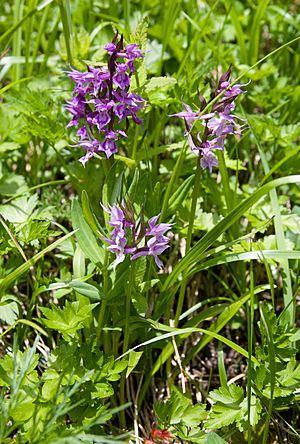Keyflower facts for kids
Quick facts for kids Keyflower |
|
|---|---|
 |
|
| Scientific classification | |
| Genus: |
Dactylorhiza
|
| Species: |
aristata
|
| Synonyms | |
|
|
The Dactylorhiza aristata, also known as the keyflower, is a beautiful type of orchid. Orchids are a large family of flowering plants known for their unique and often colorful blooms. The keyflower gets its name from the shape of its petals, which can sometimes look like an old-fashioned key.
This special plant grows naturally in several parts of the world. You can find it in countries like Japan and Korea. It also thrives in northeastern China, in provinces such as Hebei and Shandong. Further north, it's found in the Russian Far East and even in Alaska, including the Aleutian Islands.
Contents
What is an Orchid?
Orchids are one of the biggest families of flowering plants on Earth. There are tens of thousands of different orchid species. They are famous for their amazing and often very detailed flowers. These flowers come in almost every color you can imagine.
How Orchids Grow
Many orchids grow on other plants, like trees. They use the trees for support, but they don't harm them. They are not parasites. Instead, they get their water and nutrients from the air and rain. Some orchids, like the keyflower, grow directly in the soil.
Orchid Flowers
Orchid flowers are often very symmetrical. They usually have three petals and three sepals. One petal is often shaped differently and is called the "lip" or "labellum." This lip helps attract pollinators, like insects, to the flower.
Keyflower Habitat
The keyflower prefers cool, moist places. It often grows in meadows, bogs, and damp woodlands. Because it's found in places like Alaska and the Russian Far East, it can handle colder climates.
Where Keyflowers Are Found
- Asia: Japan, Korea, and parts of northeastern China.
- Russia: The far eastern regions.
- North America: Alaska, including the Aleutian Islands.
Life Cycle of the Keyflower
Like all flowering plants, the keyflower goes through a life cycle. It starts as a seed, grows into a plant, produces flowers, and then makes new seeds.
Reproduction
Keyflowers, like other orchids, rely on pollinators to help them reproduce. When an insect visits a keyflower, it might pick up pollen. Then, when the insect visits another keyflower, it can transfer the pollen, helping the plant make seeds. These seeds are very tiny, almost like dust.
Conservation
Many orchid species face challenges due to habitat loss. It's important to protect the places where plants like the keyflower grow. This helps ensure these beautiful flowers continue to thrive for future generations.
See also
 In Spanish: Dactylorhiza aristata para niños
In Spanish: Dactylorhiza aristata para niños

